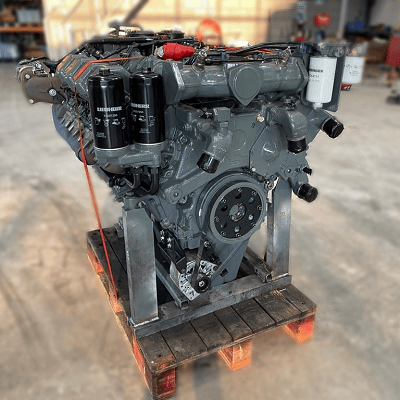The process of a dyno test on a Liebherr engine

When it comes to heavy machinery, reliability and power are paramount. Liebherr, a name synonymous with innovation and excellence in engineering, stands tall as a pioneer in the realm of heavy equipment and machinery. From towering cranes to robust excavators, Liebherr’s engineering prowess extends to the heart of these machines. We delve into the world of dyno testing a Liebherr engine, uncovering the meticulous process behind unleashing the raw power concealed within.
The foundation of excellence
Before we embark on the journey of dyno testing, it’s crucial to understand the foundation upon which Liebherr engines are built. With decades of engineering expertise and commitment to quality, Liebherr engines are crafted to withstand the most demanding environment and deliver unparalleled performance. Each component is meticulously designed and rigorously tested to ensure reliability, efficiency and longevity.
The process
1 Preparation: The engine undergoes meticulous preparation before being mounted onto the dynamo meter. This includes ensuring all connections are secure, fluids are filled to the appropriate levels, and sensors are properly calibrated.
2 Mounting: The engine is carefully mounted onto the dynamometer, a specialized device designed to simulate real-world operating conditions. Precision is paramount during this step to ensure accurate results.
3 Initial checks: Once mounted, a series of initial checks are conducted to verify proper alignment, connection integrity, and functionality of all engine systems.
4 Warm-up: The engine is started and allowed to warm up to operating temperature. This ensures consistent results and minimizes the risk of damage during testing.
5 Baseline testing: With the engine warmed up , baseline tests are conducted to establish initial performance metrics. This includes measuring power output, torque, fuel consumption, and emissions at various RPM levels.
6 Load testing: The engine is subjected to progressively increasing loads to simulate different operating conditions, such as idle, partial load and full load. This allows engineers to assess performance across the entire operating range and identify any potential issues or optimization.
7 Data analysis: Throughout the testing process, data is continuously collected and analyzed in real-time. Advanced instrumentation and software are used to monitor performance metrics and identify trends or anomalies.
8 Optimazation: Based on the data analysis, adjustments may be made to optimize engine performance. This could involve fine-tuning fuel injection timing, adjusting air-fuel ratios, or optimize turbocharger boost pressure.
9 Validation: Once testing is complete, the results are meticulously reviewed and validated against predetermined criteria and specifications. Any deviations or anomalies are thoroughly investigated to ensure accuracy and reliability.
10 Reporting: Finally, a comprehensive report is generated detailing the results of the dyno testing, including performance metrics, observations, and any recommendations for further optimization or refinement.
The outcome of dyno testing
Dyno testing a Liebherr engine is more than just a routine procedure – it’s a testament to the unwavering commitment to excellence that defines Liebherr’s engineering philosophy. By subjecting their engines to rigorous testing and analysis, Liebherr ensures that each engine delivers the uncompromising performance, reliability, and efficiency that customers expect.
In conclusion, dyno testing a Liebherr engine is not just about measuring power output. It’s about unlocking the true potential of these remarkable engines and ensuring they exceed expectations in the most challenging environments imaginable.
Stainless Steel Dutch Wire Mesh
Stainless steel dutch mesh have below features:
1. Corrosion Resistance: Stainless steel is highly resistant to corrosion, making it ideal for use in environments with high moisture content or exposure to chemicals.
2. High Strength: Stainless steel has excellent strength properties, which makes the mesh durable and capable of handling high pressures.
3. Flexibility: Depending on its weave, stainless steel mesh can be flexible enough for certain applications while still maintaining structural integrity.
4. Temperature Resistance: Stainless steel can withstand high temperatures without losing its properties, making it suitable for applications involving heat.
5. Cleanliness: Stainless steel meshes are often used in applications where cleanliness is critical, such as food processing or pharmaceutical manufacturing.
The Stainless Steel Filter Mesh have widly uses:
1. Industrial Filtration: Used in oil, gas, and chemical industries for filtering out impurities from liquids and gases.
2. Food Industry: Filters in cheese production, wine, beer, and juice purification.
3. Water Treatment: Removes contaminants from water in industrial processes or residential water filtration systems.
4. Aerospace: Filters for air intake in aircraft engines.
5. Medical Devices: Used in medical equipment filters to ensure the purity of fluids or gases.
6. Environmental Protection:Filters for air and water purification systems.
7. Automotive: Fuel filters in vehicles.
8. Electronics:Filtration in semiconductor manufacturing processes.
Accoding to the wave pattern, the stainless steel dutch mesh divide into plain weave dutch mesh, twill weave dutch mesh ect
Stainless steel dutch mesh can be customized in terms of wire diameter, mesh size (number of openings per linear inch), and overall dimensions to meet specific application requirements. if you have any inquiry, please contact with us.
I
stainless steel dutch wire mesh, Dutch Weave,Plain Dutch Weave,Dutch Weave Wire Mesh, hardware dutch wire mesh
SHENZHOU SHUANGYOU MESH CO.,LTD. , https://www.firstwiremesh.com